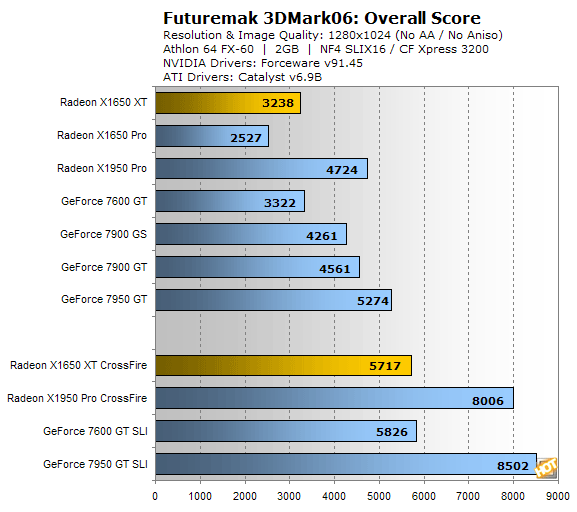ATI Radeon X1650 XT with Native CrossFire
Our Test Systems and 3DMark06

HOW WE CONFIGURED THE TEST SYSTEMS: We tested the NVIDIA based cards used in this article on an Asus A8N32-SLI nForce 4 SLIX16 chipset based motherboard. The ATI powered cards, however, were tested on an A8R32-MVP motherboard based on the CrossFire Xpress 3200 chipset. Both systems used the same AMD Athlon 64 FX-60 dual-core processor and 2GB of RAM. The first thing we did when configuring these test systems was enter each BIOS and loaded their "High Performance Defaults." The hard drives were then formatted, and Windows XP Pro was installed. When the installation was complete, we installed the latest chipset drivers available, installed all of the other drivers necessary for the rest of our components, and removed Windows Messenger from the system. Auto-Updating and System Restore were disabled, the hard drive was defragmented, and a 1024MB permanent page file was created on the same partition as the Windows installation. Lastly, we set Windows XP's Visual Effects to "best performance," installed all of the benchmarking software, and ran the tests.
|
|
|
|
Motherboard - Video Cards - Memory - Audio - Hard Drive -
|
Hardware Used: AMD Athlon 64 FX-60 (2.6GHz x 2) Asus A8N32-SLI nForce4 SLIX16 chipset Asus A8R32-MVP ATI CrossFire Xpress 3200 GeForce 7600 GT (x2) GeForce 7950 GT (x2) GeForce 7900 GT GeForce 7900 GS Radeon X1650 XT (x2) Radeon X1650 Pro Radeon X1950 Pro (x2) 2048MB Corsair XMS PC3200 RAM CAS 2 Integrated on board Western Digital "Raptor" 74GB - 10,000RPM - SATA |
Operating System - Chipset Drivers - DirectX - Video Drivers - Synthetic (DX) - DirectX - DirectX - DirectX - OpenGL - |
Relevant Software: Windows XP Professional SP2 nForce Drivers v6.86 DirectX 9.0c (August Redist.) NVIDIA Forceware v91.45 ATI Catalyst v6.8/6.9B Benchmarks Used: 3DMark06 v1.0.2 FarCry v1.33* F.E.A.R. v1.07 Half Life 2: Episode 1* Prey* * - Custom Test (HH Exclusive demo) |
|
|
|
| 3DMark06 is the latest addition to the 3DMark franchise. This version differs from 3Dmark05 in a number of ways, and now includes not only Shader Model 2.0 tests, but Shader Model 3.0 and HDR tests as well. Some of the assets from 3DMark05 have been re-used, but the scenes are now rendered with much more geometric detail and the shader complexity is vastly increased as well. Max shader length in 3DMark05 was 96 instructions, while 3DMark06 ups the number of instructions to 512. 3DMark06 also employs much more lighting, and there is extensive use of soft shadows. With 3DMark06, Futuremark has also updated how the final score is tabulated. In this latest version of the benchmark, SM 2.0 and HDR / SM3.0 tests are weighted and the CPU score is factored into the final tally as well. |

The Radeon X1650 XT just misses the mark set by the GeForce 7600 GT in 3DMark06's default test. Whether running in single-card or CrossFire modes, the X1650 XT is just a hair slower than the GeForce 7600 GT, or 7600 GT SLI configurations overall.

The reason the Radeon X1650 XT trailed the 7600 GT overall becomes evident when we look at the individual results. In the Shader Model 2.0 test, the GeForce 7600 GT was about 120 points faster than the X1650 XT in single-card mode. And when running in an SLI configuration, the 7600 GT's lead jumps to approximately 220 points.

The Radeon X1650 XT actually pulls ahead of the GeForce 7600 GT in both single and dual-card configurations in 3DMark06's Shader Model 3 / HDR test. Its margin of victory, however, is quite small, which is why it was not able to overtake the GeForce 7600 GT in the overall score.







